The strawberry tree (Arbutus unedo) or “strawberry trees” is a fruiting bush both ornamental and edible. With its bright red, strawberry-like fruits and evergreen foliage, it fits equally well in an ornamental garden or in an edible hedge. But did you know that its fruits, the arbouses, are delicious in the kitchen? Let’s discover when and how to harvest arbouses to make the most of this edible fruit in tasty recipes!
The strawberry tree, an overlooked fruit
The strawberry tree, also nicknamed "strawberry tree", is a Mediterranean evergreen bush belonging to the Ericaceae family. It generally reaches 3 to 5 metres in height, depending on growing conditions. This bush, perfectly suited to mild coastal climates and dry soil, tolerates down to -12/-15 °C. In autumn it is adorned with clusters of small white or slightly pink bell-shaped flowers that attract bees and other pollinators. But main attraction of the strawberry tree is its fruits, the arbouses, small spherical berries that ripen in autumn, changing from green to a vivid red, giving them a strawberry-like appearance. The strawberry tree is undemanding and drought-resistant. It thrives in well-drained, non-calcareous soil and prefers a sunny or part-shaded position, while being sheltered from cold winds. Versatile, it can be planted in an informal hedge, as a specimen plant or incorporated into a mixed border.
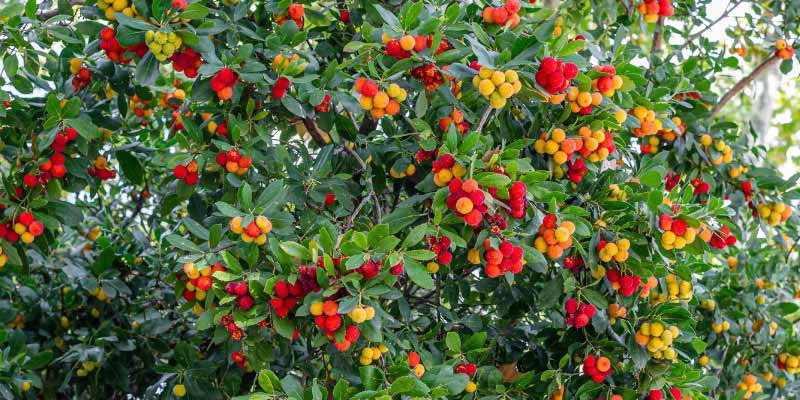
The fruits of the strawberry tree: the arbouses
Arbouses are spherical berries 1 to 3 cm in diameter. Their skin is rough and bumpy, turning a vivid red at ripeness, resembling a strawberry in appearance. Inside, flesh is yellow-orange, sweet, with a granulose texture. This granulose character, due to presence of tiny seeds, can make the fruit less appealing raw to some. However, they show their full potential in culinary preparations where they release their aromas fully.
Their flavour, sweet with a slight tang, recalls a mix of pear and fig with sometimes a hint of bitterness. They remain, however, far less flavoursome than strawberries, which is why they are usually enjoyed cooked rather than raw.
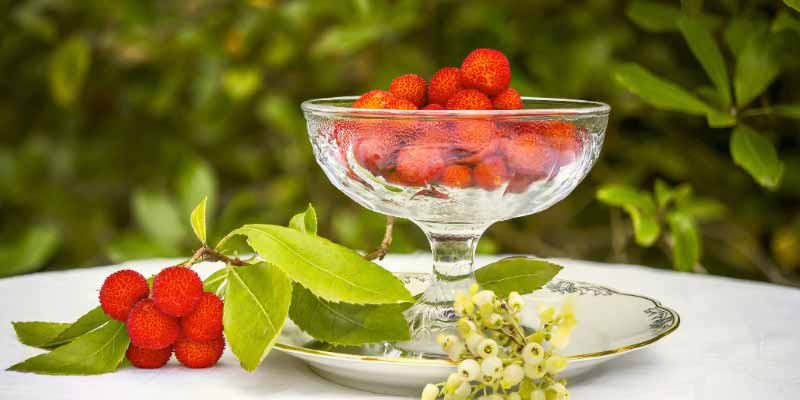
How to harvest arbouses?
Their ripening period coincides with the flowering of the strawberry tree. This creates a rare and magnificent spectacle, where delicate flowers and red fruits coexist on the same branch. Arbouses ripen in autumn, generally between October and December. A productive strawberry tree can offer hundreds of fruits while still in flower.
Harvesting and storage tips:
- Wait until fruits are fully red and slightly soft under finger pressure.
- Handle them gently, as they are fragile and deteriorate quickly after harvest.
- Store them in the refrigerator in an airtight container for 2 to 3 days. They spoil quickly and become soft.
- You can freeze them to extend their shelf life in freezer bags or boxes. They keep up to 6 months and can be used directly in cooking (in smoothies, for example).
- Jams, jellies or syrups keep for several months in sterilised jars. This is an excellent way to enjoy their flavour year-round.
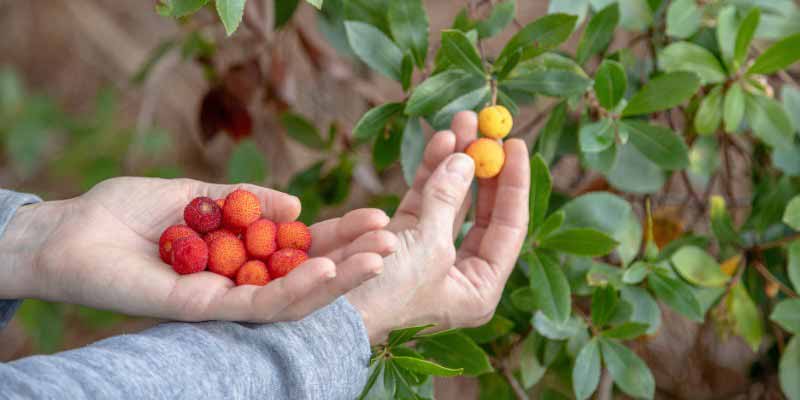
How to eat strawberry-tree fruits?
Arbouses, with their sweet and tangy flavour, are easy to incorporate into many recipes. However, their granulose texture and fragility require a few precautions to get the best from them.
Should arbouses be peeled?
No, arbouses are not peeled! Their red, bumpy skin is edible and rich in nutrients. It also contains much of the aromas and pigments responsible for their attractive colour. If the rough texture bothers you, you can blend or sieve the preparation for a smoother result, as in coulis or jellies.
How to remove seeds from arbouses?
To remove seeds from arbouses, simplest method is to simmer them gently with a little water until soft then pass them through a sieve or fine strainer. Press with a spatula to extract pulp while retaining seeds. For an even smoother texture, you can first blend the arbouses, raw or cooked, before straining the purée through a sieve or clean cloth. These techniques produce a smooth pulp, perfect for jams, coulis or jellies. Seeds, harmless though they are, are removed when granulose texture is not desired in the recipe.
Recipes for cooking arbouses
Fresh arbouses are perfect for a quick snack. In a fruit salad, for example, pair them with citrus trees, kiwis and red fruits. Their vivid red colour adds a bright touch. However, because of their rough texture and limited flavour, they are mainly eaten cooked. Species name of the bush, unedo, comes from Latin unum edo, meaning "I eat only one", which says a lot... Here are some detailed recipe suggestions:
Arbouse jam
Jam is the most popular use for arbouses.
Required equipment :
- A large saucepan or stockpot
- A wooden spoon
- A sieve or fine strainer (if you want to remove seeds)
- A ladle
- Glass jars with airtight lids (sterilised)
- A knife
- A fork or blender (to crush or blend arbouses)
How to make it?
- Wash and hull 1 kg of fully ripe arbouses.
- Blend them or crush them lightly with a fork.
- Add 500 g sugar and juice of one lemon to preserve colour and balance flavours.
- Cook the mixture over low heat for 20 to 30 minutes, stirring regularly.
- If granulose texture bothers you, pass the jam through a sieve to remove seeds.
- Pour into sterilised jars, seal well and invert to create vacuum seal.
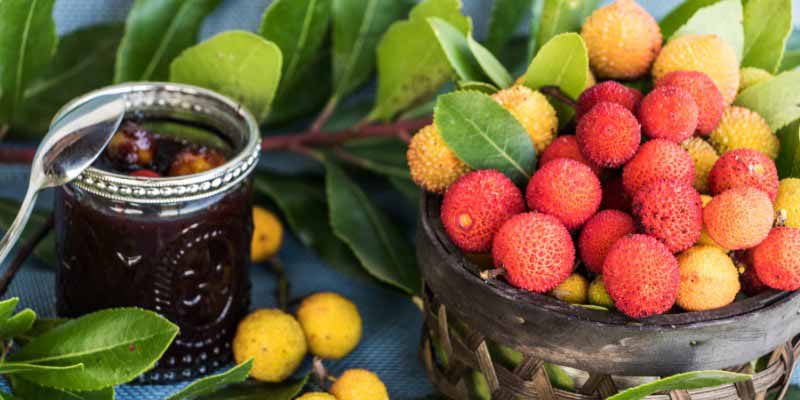
Arbouse coulis
Arbouse coulis is ideal for topping desserts.
Tip: Add a little honey or spices (such as cinnamon) to enhance flavour. Use on cheesecake, pancakes or even stirred into natural yoghurt.
Homemade arbouse liqueur
Required equipment :
- An airtight glass jar (preserving jar)
- A saucepan
- A spoon or spatula
- A funnel
- A fine strainer or clean cloth for filtering
- A clean airtight bottle to store the liqueur
Ingredients :
- 500 g fully ripe arbouses
- 500 ml 40% alcohol (vodka or neutral fruit spirit)
- 200 g sugar
- 200 ml water
- 1 vanilla pod (facultative)
Preparation:
- Wash and dry arbouses gently, then place them in an airtight glass jar.
- Add alcohol, ensuring fruits are completely submerged. If you want to flavour the liqueur, add a vanilla pod split in two.
- Close jar and let macerate for one month in a cool, dark place. Shake jar gently every 2–3 days.
- After maceration, prepare a syrup by heating water and sugar until fully dissolved. Let cool.
- Filter the alcoholic preparation to remove arbouses, then mix with cooled syrup.
- Pour liqueur into a clean bottle and let rest another one to two weeks to develop flavours before tasting.
Arbouses in syrup
Required equipment :
- Sterilised glass jars with airtight lids
- A large saucepan
- A ladle
- A large pot for sterilising jars (with rack or cloth at bottom)
- Jar lifter (or a clean cloth) to handle hot jars
Ingredients :
- 500 g ripe but firm arbouses
- 300 g sugar
- 500 ml water
- Juice of half a lemon
Preparation :
- Wash arbouses carefully to avoid damaging them, then drain.
- For better preservation, sterilise jars by immersing them in a pot of boiling water for 20 minutes, then let cool to room temperature.
- Prepare a syrup by bringing water, sugar and lemon juice to the boil. Boil 2 to 3 minutes until mixture becomes slightly thickened.
- Place arbouses in sterilised jars, pressing them down gently but without crushing.
- Pour hot syrup over the fruits, ensuring they are fully covered.
- Seal jars tightly.
- Store arbouses in syrup in a cool, dry place. Wait a few days before consuming to allow flavours to meld.
My view: These two recipes allow enjoying arbouses long after harvest, whether as an aromatic liqueur or as delicately sugared preserved fruits.































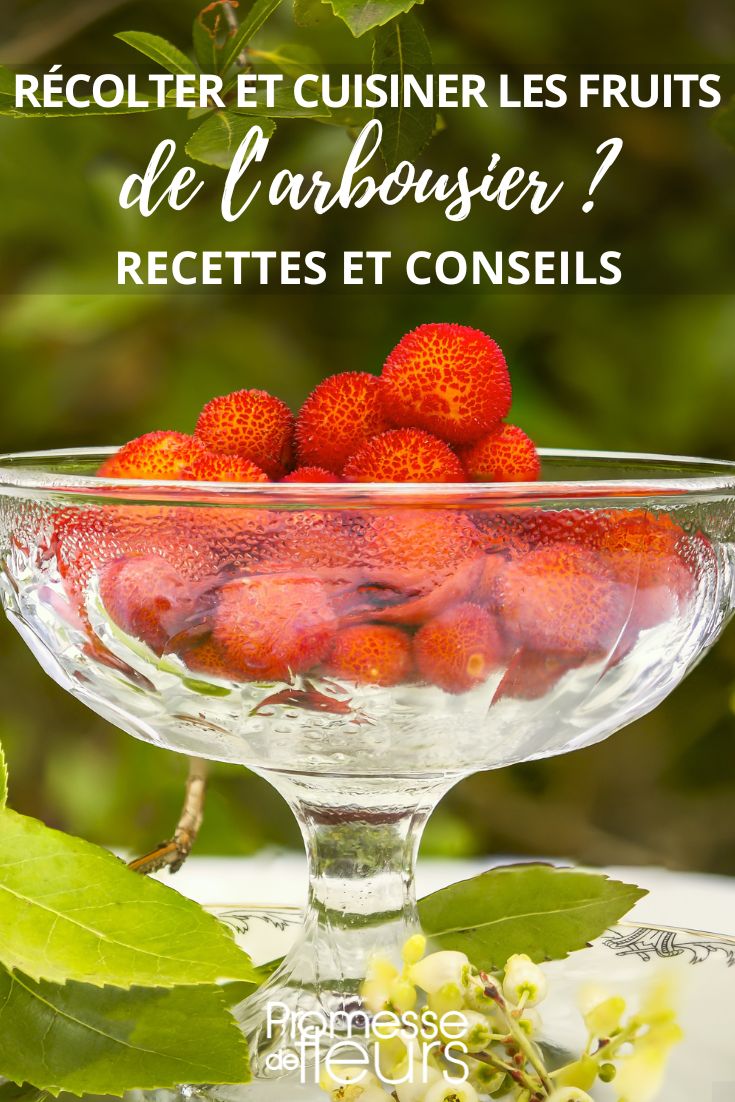
Comments